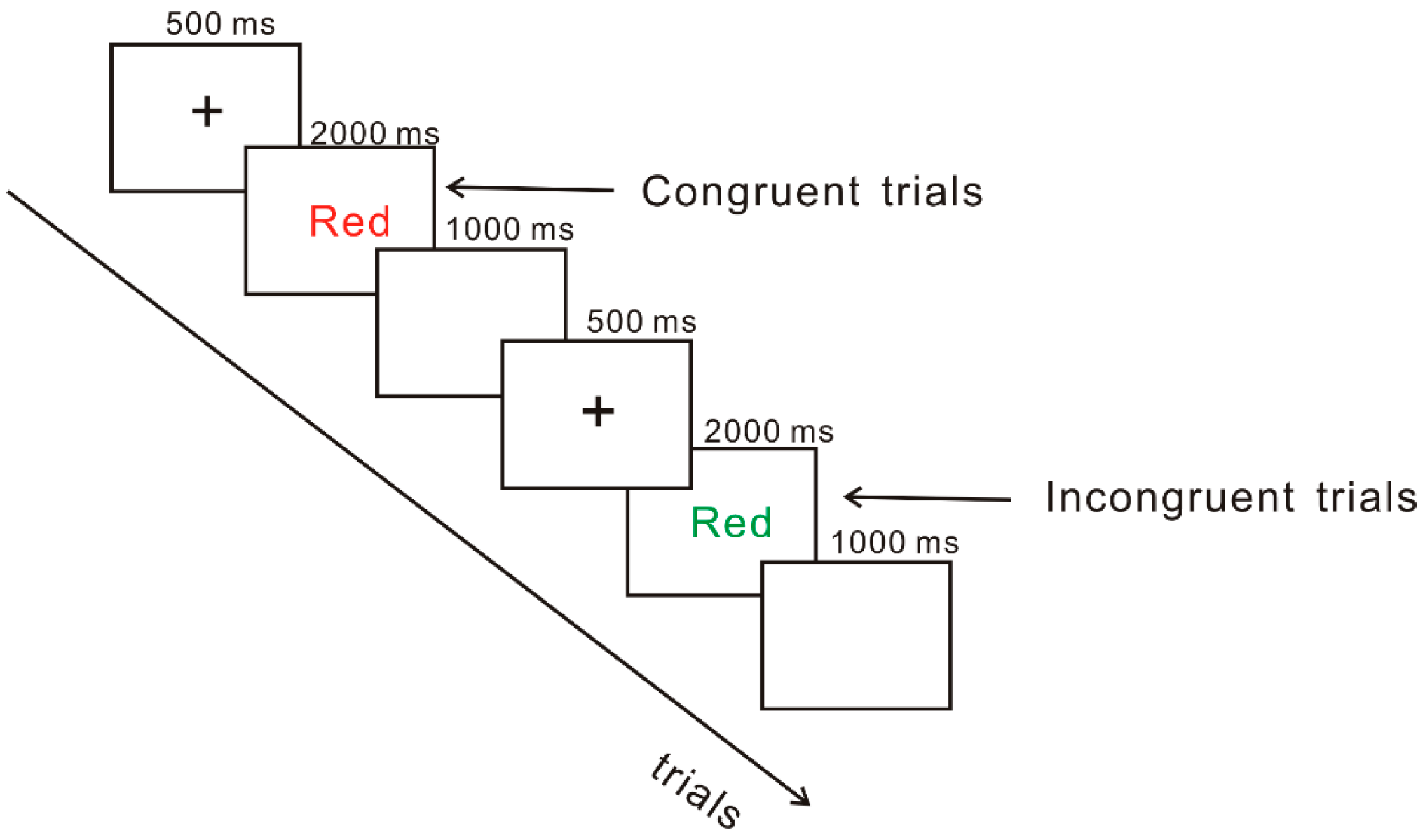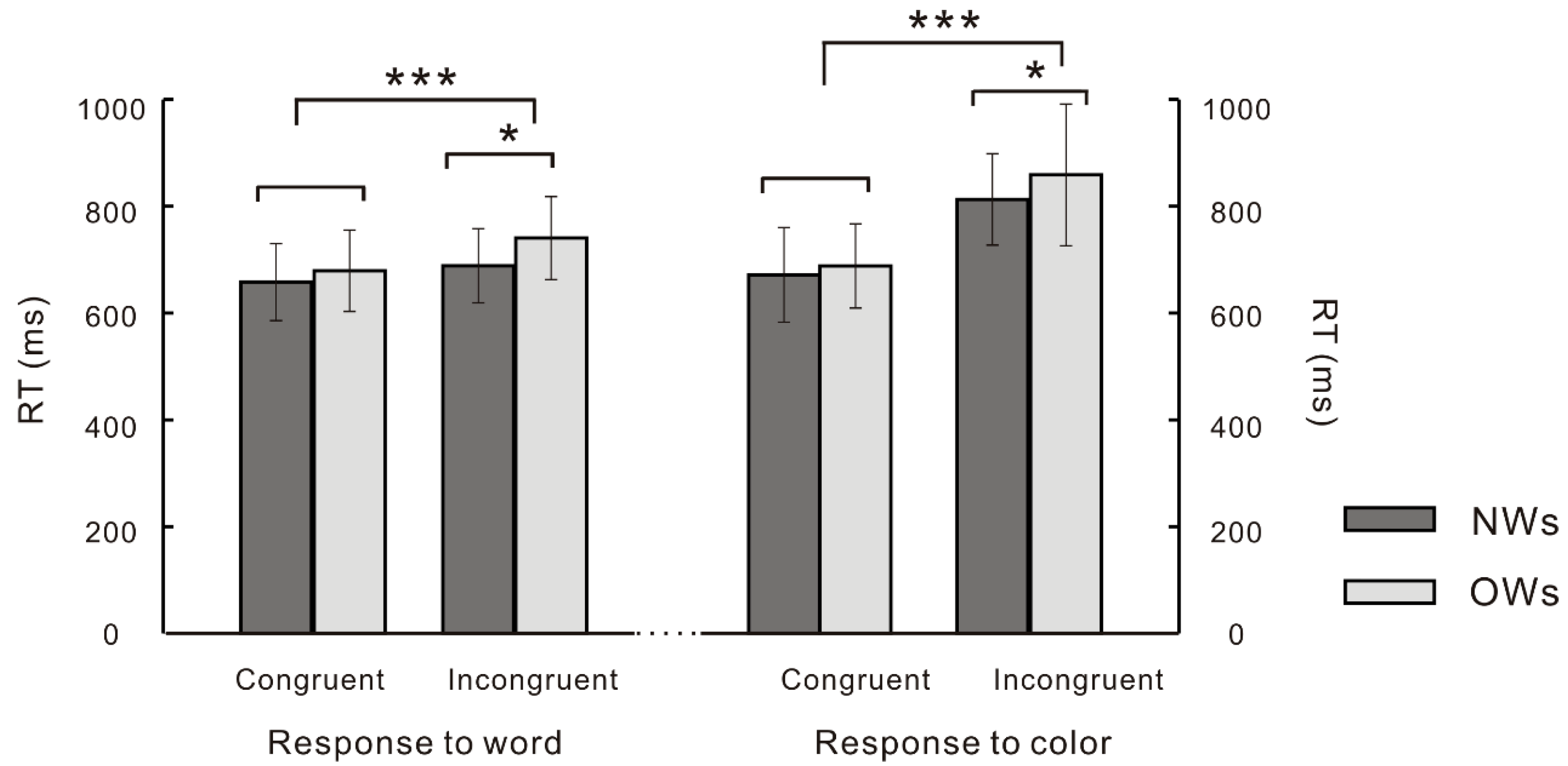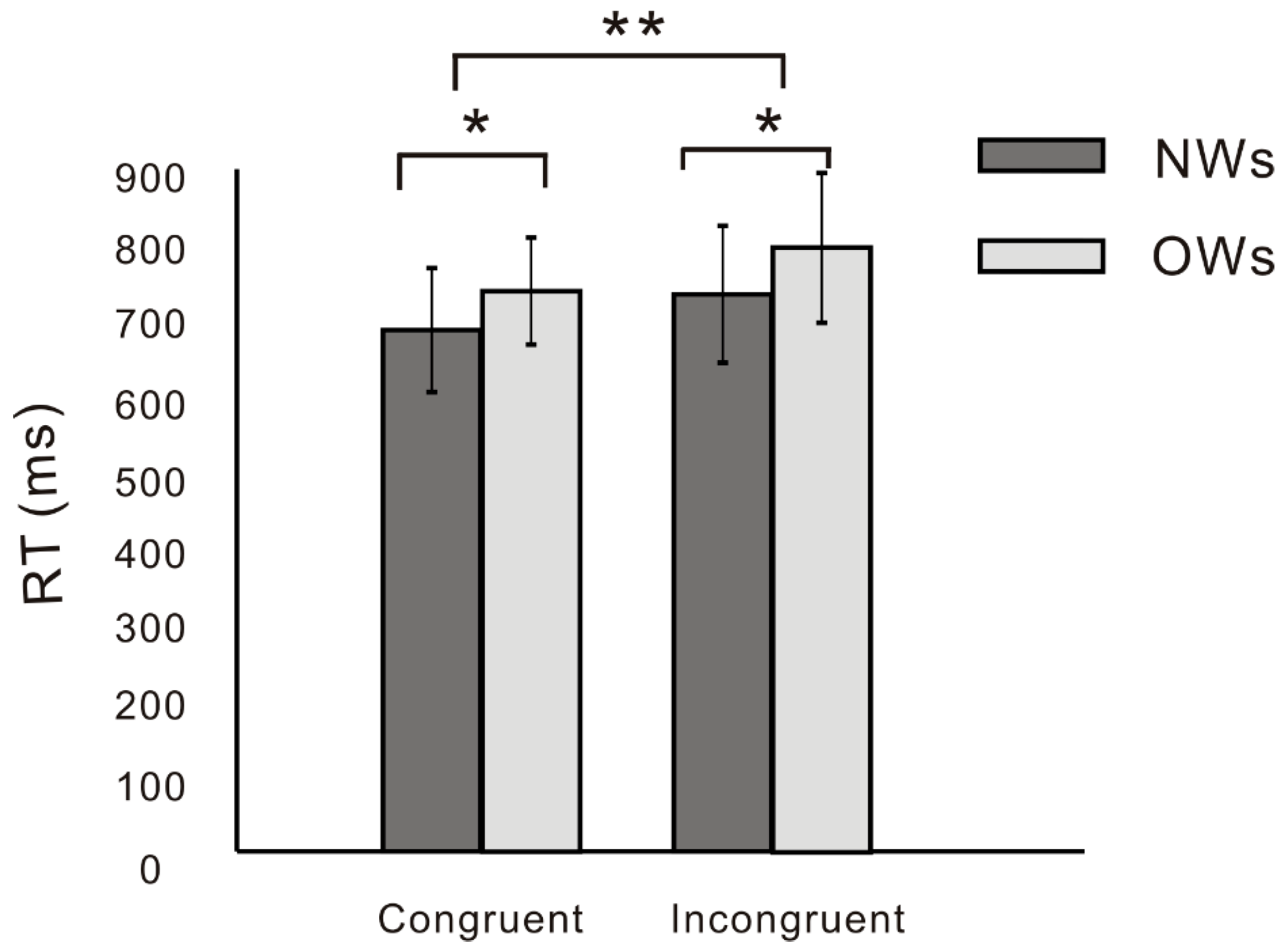Decreased Conflict Control in Overweight Chinese Females: Behavioral and Event-Related Potentials Evidence
Abstract
1. Introduction
2. Methods
2.1. Participants
2.2. Self-Report Measures
2.2.1. Hunger, Desire to Eat, and Body Satisfaction
2.2.2. Negative Physical Self Scale—Fatness Concern (NPS–F)
2.2.3. Dutch Eating Behavior Questionnaire—Restraint Scale (DEBQ–R)
2.3. Experimental Tasks
2.3.1. Color–Word Stroop Task
2.3.2. Food-Related Conflict Task
2.4. Behavioral Analyses
2.5. ERPs Recording and Analyses
3. Results
3.1. Self-Report Results
3.2. Behavioral Results
3.2.1. Color–Word Stroop Task
3.2.2. Food-Related Conflict Task
3.3. ERPs Results
3.3.1. N2
3.3.2. P3
3.3.3. N450
3.3.4. LPC
4. Discussion
5. Conclusions
Author Contributions
Funding
Acknowledgments
Conflicts of Interest
References
- Hesse, S.; Rullmann, M.; Luthardt, J.; Winter, K.; Hankir, M.K.; Becker, G.A.; Schinke, C. Central serotonin transporter availability in highly obese individuals compared with non-obese controls: A [11 C] DASB positron emission tomography study. Eur. J. Nucl. Med. Mol. Imaging 2016, 43, 1096–1104. [Google Scholar] [CrossRef] [PubMed]
- Pi-Sunyer, F.X. The obesity epidemic: Pathophysiology and consequences of obesity. Obes. Res. 2012, 10, 97S–104S. [Google Scholar] [CrossRef] [PubMed]
- NCD Risk Factor Collaboration (NCD-RisC). Trends in adult body-mass index in 200 countries from 1975 to 2014: A pooled analysis of 1698 population-based measurement studies with 19.2 million participants. Lancet 2016, 387, 1377–1396. [Google Scholar] [CrossRef]
- Friedemann, C.; Heneghan, C.; Mahtani, K.; Thompson, M.; Perera, R.; Ward, A.M. Cardiovascular disease risk in healthy children and its association with body mass index: systematic review and meta-analysis. BMJ 2012, 345, e4759. [Google Scholar] [CrossRef] [PubMed]
- Cournot, M.C.M.J.; Marquie, J.C.; Ansiau, D.; Martinaud, C.; Fonds, H.; Ferrieres, J.; Ruidavets, J.B. Relation between body mass index and cognitive function in healthy middle-aged men and women. Neurology 2006, 67, 1208–1214. [Google Scholar] [CrossRef] [PubMed]
- Fitzpatrick, A.L.; Kuller, L.H.; Lopez, O.L.; Diehr, P.; O’Meara, E.S.; Longstreth, W.T.; Luchsinger, J.A. Midlife and late-life obesity and the risk of dementia: Cardiovascular health study. Arch. Neurol. 2009, 66, 336–342. [Google Scholar] [CrossRef] [PubMed]
- Karlsson, H.K.; Tuulari, J.J.; Hirvonen, J.; Lepomäki, V.; Parkkola, R.; Hiltunen, J.; Nuutila, P. Obesity is associated with white matter atrophy: A combined diffusion tensor imaging and voxel-based morphometric study. Obesity 2013, 21, 2530–2537. [Google Scholar] [CrossRef] [PubMed]
- Volkow, N.; Wang, G.J.; Fowler, J.S.; Tomasi, D.; Baler, R. Food and Drug Reward: Overlapping Circuits in Human Obesity and Addiction. Brain Imaging in Behavioral Neuroscience; Springer: Berlin, Germany, 2011; pp. 1–24. [Google Scholar]
- Volkow, N.D.; Wang, G.J.; Tomasi, D.; Baler, R.D. Obesity and addiction: Neurobiological overlaps. Obes. Rev. 2013, 14, 2–18. [Google Scholar] [CrossRef] [PubMed]
- Botvinick, M.M.; Braver, T.S.; Barch, D.M.; Carter, C.S.; Cohen, J.D. Conflict monitoring and cognitive control. Psychol. Rev. 2001, 108, 624–652. [Google Scholar] [CrossRef]
- Kittel, R.; Schmidt, R.; Hilbert, A. Executive functions in adolescents with binge-eating disorder and obesity. Int. J. Eat. Disord. 2017, 50, 933–941. [Google Scholar] [CrossRef]
- Restivo, M.R.; McKinnon, M.C.; Frey, B.N.; Hall, G.B.; Syed, W.; Taylor, V.H. The impact of obesity on neuropsychological functioning in adults with and without major depressive disorder. PLoS ONE 2017, 12, e0176898. [Google Scholar] [CrossRef] [PubMed]
- Sweat, V.; Yates, K.F.; Migliaccio, R.; Convit, A. Obese adolescents show reduced cognitive processing speed compared with healthy weight peers. Child. Obes. 2017, 13, 190–196. [Google Scholar] [CrossRef] [PubMed]
- Reyes, S.; Peirano, P.; Peigneux, P.; Lozoff, B.; Algarin, C. Inhibitory control in otherwise healthy overweight 10-year-old children. Int. J. Obes. 2015, 39, 1230. [Google Scholar] [CrossRef] [PubMed]
- Calvo, D.; Galioto, R.; Gunstad, J.; Spitznagel, M.B. Uncontrolled eating is associated with reduced executive functioning. Clin. Obes. 2014, 4, 172–179. [Google Scholar] [CrossRef] [PubMed]
- Chamberlain, S.R.; Derbyshire, K.L.; Leppink, E.; Grant, J.E. Obesity and dissociable forms of impulsivity in young adults. CNS Spectrums 2015, 20, 500–507. [Google Scholar] [CrossRef] [PubMed]
- Chen, S.; Jia, Y.; Woltering, S. Neural differences of inhibitory control between adolescents with obesity and their peers. Int. J. Obes. 2018, 42, 1753. [Google Scholar] [CrossRef]
- Kamijo, K.; Pontifex, M.B.; Khan, N.A.; Raine, L.B.; Scudder, M.R.; Drollette, E.S.; Hillman, C.H. The negative association of childhood obesity to cognitive control of action monitoring. Cereb. Cortex 2012, 24, 654–662. [Google Scholar] [CrossRef] [PubMed]
- Deux, N.; Schlarb, A.A.; Martin, F.; Holtmann, M.; Hebebrand, J.; Legenbauer, T. Overweight in adolescent, psychiatric inpatients: A problem of general or food-specific impulsivity? Appetite 2017, 112, 157–166. [Google Scholar] [CrossRef]
- Yang, Y.; Shields, G.S.; Guo, C.; Liu, Y. Executive function performance in obesity and overweight individuals: A meta-analysis and review. Neurosci. Biobehav. Rev. 2018, 84, 225–244. [Google Scholar] [CrossRef]
- Moreno-López, L.; Soriano-Mas, C.; Delgado-Rico, E.; Rio-Valle, J.S.; Verdejo-García, A. Brain structural correlates of reward sensitivity and impulsivity in adolescents with normal and excess weight. PLoS ONE 2012, 7, e49185. [Google Scholar] [CrossRef]
- Verdejo-García, A.; Pérez-Expósito, M.; Schmidt-Río-Valle, J.; Fernández-Serrano, M.J.; Cruz, F.; Pérez-García, M.; Campoy, C. Selective alterations within executive functions in adolescents with excess weight. Obesity 2010, 18, 1572–1578. [Google Scholar] [CrossRef] [PubMed]
- Wu, X.; Nussbaum, M.A.; Madigan, M.L. Executive function and measures of fall risk among people with obesity. Percept. Motor Skill. 2016, 122, 825–839. [Google Scholar] [CrossRef] [PubMed]
- Yau, P.L.; Kang, E.H.; Javier, D.C.; Convit, A. Preliminary evidence of cognitive and brain abnormalities in uncomplicated adolescent obesity. Obesity 2014, 22, 1865–1871. [Google Scholar] [CrossRef] [PubMed]
- Nijs, I.M.; Franken, I.H.; Muris, P. Food-related Stroop interference in obese and normal-weight individuals: Behavioral and electrophysiological indices. Eat. Behav. 2010, 11, 258–265. [Google Scholar] [CrossRef] [PubMed]
- Carbine, K.A.; Duraccio, K.M.; Kirwan, C.B.; Muncy, N.M.; LeCheminant, J.D.; Larson, M.J. A direct comparison between ERP and fMRI measurements of food-related inhibitory control: Implications for BMI status and dietary intake. NeuroImage 2018, 166, 335–348. [Google Scholar] [CrossRef]
- Folstein, J.R.; Van Petten, C. Influence of cognitive control and mismatch on the N2 component of the ERP: A review. Psychophysiology 2008, 45, 152–170. [Google Scholar] [CrossRef] [PubMed]
- Qiu, J.; Luo, Y.; Wang, Q.; Zhang, F.; Zhang, Q. Brain mechanism of stroop interference effect in chinese characters. Brain Res. 2006, 1072, 186–193. [Google Scholar] [CrossRef] [PubMed]
- Xue, S.; Ren, G.; Kong, X.; Liu, J.; Qiu, J. Electrophysiological correlates related to the conflict adaptation effect in an emotional conflict task. Neurosci. Lett. 2015, 584, 219–223. [Google Scholar] [CrossRef]
- Silton, R.L.; Heller, W.; Towers, D.N.; Engels, A.S.; Spielberg, J.M.; Edgar, J.C.; Miller, G.A. The time course of activity in dorsolateral prefrontal cortex and anterior cingulate cortex during top-down attentional control. NeuroImage 2010, 50, 1292–1302. [Google Scholar] [CrossRef]
- Albert, J.; López-Martín, S.; Hinojosa, J.A.; Carretié, L. Spatiotemporal characterization of response inhibition. NeuroImage 2013, 76, 272–281. [Google Scholar] [CrossRef]
- Polich, J. Updating P300: An integrative theory of P3a and P3b. Clin. Neurophysiol. 2007, 118, 2128–2148. [Google Scholar] [CrossRef] [PubMed]
- Hajcak, G.; Nieuwenhuis, S. Reappraisal modulates the electrocortical response to unpleasant pictures. Cognitive, Affect. Behav. Neurosci. 2006, 6, 291–297. [Google Scholar]
- Hajcak, G.; MacNamara, A.; Foti, D.; Ferri, J.; Keil, A. The dynamic allocation of attention to emotion: Simultaneous and independent evidence from the late positive potential and steady state visual evoked potentials. Biol. Psychol. 2013, 92, 447–455. [Google Scholar] [CrossRef] [PubMed]
- Holm-Denoma, J.M.; Joiner, T.E., Jr.; Vohs, K.D.; Heatherton, T.F. The “freshman fifteen” (the “freshman five” actually): Predictors and possible explanations. Health Psychol. 2008, 27, S3. [Google Scholar] [CrossRef] [PubMed]
- Wang, Y.; Dong, D.; Todd, J.; Du, J.; Yang, Z.; Lu, H.; Chen, H. Neural correlates of restrained eaters’ high susceptibility to food cues: An fMRI study. Neurosci. Lett. 2016, 631, 56–62. [Google Scholar] [CrossRef] [PubMed]
- Zhang, B.; Tian, D.; Yu, C.; Zhang, J.; Tian, X.; von Deneen, K.M.; Liu, Y. Altered baseline brain activities before food intake in obese men: A resting state fMRI study. Neurosci. Lett. 2015, 584, 156–161. [Google Scholar] [CrossRef] [PubMed]
- Chen, H.; Jackson, T.; Huang, X. The negative physical self scale: Initial development and validation in samples of Chinese adolescents and young adults. Body Image 2006, 3, 401–412. [Google Scholar] [CrossRef]
- Van Strien, T.; Frijters, J.E.; Van Staveren, W.A.; Defares, P.B.; Deurenberg, P. The predictive validity of the Dutch restrained eating scale. Int. J. Eat. Disord. 1986, 5, 747–755. [Google Scholar] [CrossRef]
- Zhou, Y.; Liu, Y.; Du, J.; Chen, H. Effects of food exposure on food-related inhibitory control in restrained eaters: An ERP study. Neurosci. Lett. 2018, 672, 130–135. [Google Scholar] [CrossRef]
- Kong, F.; Zhang, Y.; Chen, H. Inhibition ability of food cues between successful and unsuccessful restrained eaters: A two-choice oddball task. PLoS ONE 2015, 10, e0120522. [Google Scholar] [CrossRef]
- Delorme, A.; Makeig, S. EEGLAB: An open source toolbox for analysis of single-trial EEG dynamics including independent component analysis. J. Neurosci. Meth. 2004, 134, 9–21. [Google Scholar] [CrossRef] [PubMed]
- Janssen, L.K.; Duif, I.; van Loon, I.; Wegman, J.; de Vries, J.H.; Cools, R.; Aarts, E. Loss of lateral prefrontal cortex control in food-directed attention and goal-directed food choice in obesity. NeuroImage 2017, 146, 148–156. [Google Scholar] [CrossRef] [PubMed]
- Tarantino, V.; Vindigni, V.; Bassetto, F.; Pavan, C.; Vallesi, A. Behavioral and electrophysiological correlates of cognitive control in ex-obese adults. Biol. Psychol. 2017, 127, 198–208. [Google Scholar] [CrossRef] [PubMed]
- Yeung, N.; Botvinick, M.M.; Cohen, J.D. The neural basis of error detection: Conflict monitoring and the error-related negativity. Psychol. Rev. 2004, 111, 931. [Google Scholar] [CrossRef] [PubMed]
- Senderecka, M.; Grabowska, A.; Szewczyk, J.; Gerc, K.; Chmylak, R. Response inhibition of children with ADHD in the stop-signal task: An event-related potential study. Int. J. Psychophysiol. 2012, 85, 93–105. [Google Scholar] [CrossRef] [PubMed]
- Kok, A. On the utility of P3 amplitude as a measure of processing capacity. Psychophysiology 2001, 38, 557–577. [Google Scholar] [CrossRef]
- Polich, J.; Kok, A. Cognitive and biological determinants of P300: An integrative review. Biol. Psychol. 1995, 41, 103–146. [Google Scholar] [CrossRef]
- Heinze, M.; Wölfling, K.; Grüsser, S.M. Cue-induced auditory evoked potentials in alcoholism. Clin. Neurophysiol. 2007, 118, 856–862. [Google Scholar] [CrossRef]
- Watson, T.D.; Garvey, K.T. Neurocognitive correlates of processing food-related stimuli in a Go/No-go paradigm. Appetite 2013, 71, 40–47. [Google Scholar] [CrossRef]
- Matsumoto, K.; Tanaka, K. The role of the medial prefrontal cortex in achieving goals. Curr. Opin. Neurobiol. 2004, 14, 178–185. [Google Scholar] [CrossRef]
- Myrseth, K.O.R.; Fishbach, A. Self-control: A function of knowing when and how to exercise restraint. Curr. Dir. Psychol. Sci. 2009, 18, 247–252. [Google Scholar] [CrossRef]
- Stroebe, W.; Mensink, W.; Aarts, H.; Schut, H.; Kruglanski, A.W. Why dieters fail: Testing the goal conflict model of eating. J. Exp. Soc. Psychol. 2008, 44, 26–36. [Google Scholar] [CrossRef]
- Fearnbach, S.N.; Silvert, L.; Pereira, B.; Boirie, Y.; Duclos, M.; Keller, K.L.; Thivel, D. Reduced neural responses to food cues might contribute to the anorexigenic effect of acute exercise observed in obese but not lean adolescents. Nutr. Res. 2017, 44, 76. [Google Scholar] [CrossRef] [PubMed]






| Variable | OWs (M ± SD) | NWs (M ± SD) |
|---|---|---|
| n = 22 | n = 21 | |
| Age | 20.55 (2.06) | 20.00 (1.48) |
| BMI ** | 28.84 (3.86) | 20.81 (1.49) |
| NPS-F * | 2.32 (1.04) | 1.56 (0.85) |
| DEBQ-R | 35.47 (6.5) | 34.07 (10.13) |
| Hunger | 53.64 (28.21) | 37.62 (24.01) |
| Desire | 49.77 (26.07) | 43.33 (26.52) |
| Body satisfaction ** | 22.27 (18.56) | 50.95 (23.43) |
© 2019 by the authors. Licensee MDPI, Basel, Switzerland. This article is an open access article distributed under the terms and conditions of the Creative Commons Attribution (CC BY) license (http://creativecommons.org/licenses/by/4.0/).
Share and Cite
Liu, Y.; Quan, H.; Song, S.; Zhang, X.; Yang, C.; Chen, H. Decreased Conflict Control in Overweight Chinese Females: Behavioral and Event-Related Potentials Evidence. Nutrients 2019, 11, 1450. https://doi.org/10.3390/nu11071450
Liu Y, Quan H, Song S, Zhang X, Yang C, Chen H. Decreased Conflict Control in Overweight Chinese Females: Behavioral and Event-Related Potentials Evidence. Nutrients. 2019; 11(7):1450. https://doi.org/10.3390/nu11071450
Chicago/Turabian StyleLiu, Yong, Huan Quan, Shiqing Song, Xuemeng Zhang, Chao Yang, and Hong Chen. 2019. "Decreased Conflict Control in Overweight Chinese Females: Behavioral and Event-Related Potentials Evidence" Nutrients 11, no. 7: 1450. https://doi.org/10.3390/nu11071450
APA StyleLiu, Y., Quan, H., Song, S., Zhang, X., Yang, C., & Chen, H. (2019). Decreased Conflict Control in Overweight Chinese Females: Behavioral and Event-Related Potentials Evidence. Nutrients, 11(7), 1450. https://doi.org/10.3390/nu11071450




